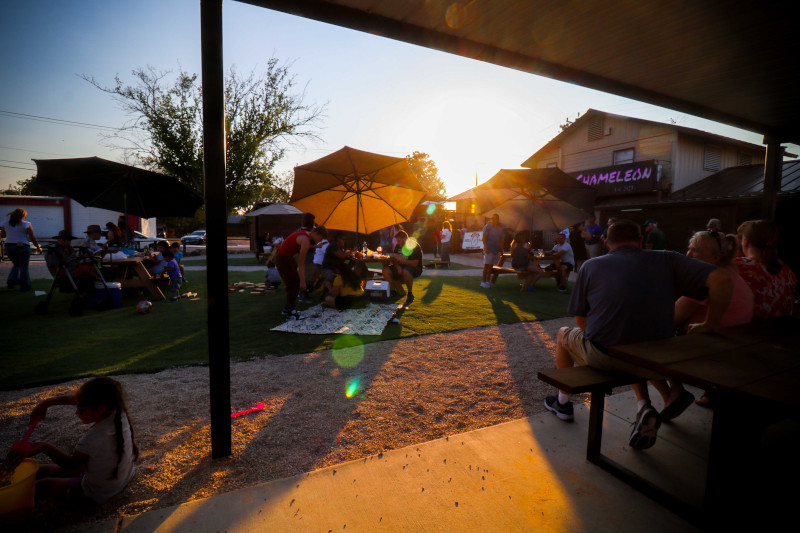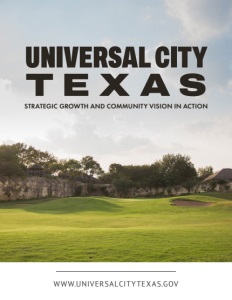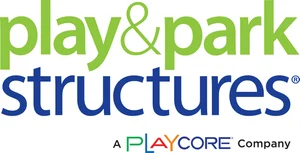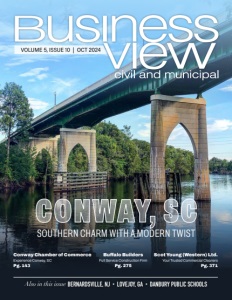Universal City, Texas
Strategic Growth and Community Vision in Action
Discovering how this city is transforming its future through strategic development, innovative collaborations, and a commitment to community-driven progress.
Universal City, Texas, might not grab headlines like some of its larger neighbors, but what it lacks in size, it more than makes up for in community spirit and strategic importance. With a population of just over 21,000, this small city located northeast of San Antonio punches well above its weight, thanks to its deep-rooted connections among residents and its integral role as the gateway to Joint Base San Antonio Randolph.
“One of the noteworthy items is that we have a community that is very connected to each other,” says Kim Turner, the City Manager. “Even though we’re a city of 21,000, there’s a lot of connectivity between residents, whether through volunteering for the city or their interaction while they were in the military,” Turner emphasizes how these interactions create a vibrant community atmosphere, where everyone seems to know someone, creating a sense of belonging that’s hard to find in larger cities.
Universal City’s close relationship with the military is deeply ingrained in daily life. “We are the gateway to Joint Base San Antonio Randolph,” Turner says, highlighting the mutual importance of this connection. Many residents—service members, veterans, and civilians—share a common bond through their ties to the base, shaping the city’s identity. This camaraderie extends beyond military influence, creating a tight-knit community where “you don’t get lost here,” Turner notes, referring to the city’s close-knit nature.
Universal City’s Communications Director, Kathy Williams, highlights the city’s patriotic pride: “Many residents here are retired from Randolph Air Force Base. Our level of patriotic pride is a lot higher than most places.” This pride is woven into the city’s identity, even reflected in its red, white, and blue logo. The town was founded because of the base and continues to serve both active duty and retired military. Military uniforms are a common sight, and local businesses, like a restaurant honoring veterans, showcase this shared respect and connection to the military.
Reimagining the Heart of Universal City
Universal City may not have a traditional downtown, but that doesn’t mean it lacks vision or ambition. “We don’t have a downtown, per se,” Turner explains, acknowledging that while Universal City lacks a conventional downtown core, it has a plan to fill that gap. “The Aviation District Revitalization Plan we have in place is to create a downtown for the city.”
This vision isn’t just a distant dream; it’s a careful plan that has been in the works for several years. Michael Cassata, the Director of Development Services and Economic Development Corporation (EDC), shares more about the progress. “We hired a consultant to help us generate that master plan about four and a half years ago,” he says. It’s probably like a 10-to-15-year plan, and slowly, we’ve made some strides over time.”
These strides are visible through new businesses that have breathed life into the area. “There was an old Air Force bar right on the railroad tracks, right across the street from the base, that the EDC helped revitalize into a very successful microbrewery,” Cassata notes. This microbrewery, aptly named Gather Brewery, has become a gathering spot for locals, drawing crowds during lunch, evenings, and weekends—when the area previously saw little activity.
A new food truck park near Pat Booker Road has also revitalized the area, attracting visitors and boosting community spirit. Cassata notes its success in drawing people to that part of town. However, the Aviation District’s vision goes beyond new businesses—it’s about creating “life at night.” Turner explains the focus on offering evening options like wine bars, dance classes, and cafés, nurturing a more vibrant, walkable community. The EDC is actively acquiring properties to develop a “mixed-use New Urbanist environment,” mimicking a traditional downtown.
Investing in Infrastructure
As Universal City positions itself for future growth, the focus on critical infrastructure is more important than ever. Randy Luensmann, the Public Works Director, outlines the ambitious plans already underway, starting with street improvements.
“The council has approved about $30 million worth of street improvements and have authorized the first phase of it, about $6 million,” he shares. These upgrades are concentrated primarily in residential areas, targeting the everyday streets where residents live and work. In addition to street improvements, Luensmann highlights ongoing efforts to bolster other critical systems.
“I do a lot of Community Development Block Grant (CDBG) projects with residential and our low-residential areas,” he notes. These grants are essential to infrastructure upgrades in the city’s underserved neighborhoods, ensuring all residents benefit from improved services. With support from Bexar County Commissioners, these projects are a regular part of the city’s infrastructure strategy, providing a reliable pipeline of funding and development each year.
Universal City is also investing over $1 million in sewer infrastructure upgrades, supported by a grant from Bexar County’s American Rescue Plan Act (ARPA) funding. A significant sewer rehab project along Kitty Hawk is part of the broader Reunion Project, aimed at revitalizing critical areas of the city. “Every year, I’m budgeting annual sewer and water infrastructure projects,” Luensmann says. The city is also preparing for new residential developments in its extraterritorial jurisdiction (ETJ), including Unit Three of a new and already thriving neighborhood, Cibolo Crossing, and a new project in Orchard Park. This will bring more homes and potential retail spaces, further driving the city’s expansion.

Revitalizing Parks
Universal City’s parks have become more than just recreational spaces—they are vibrant community hubs that draw people from all over. Over the past six to seven years, Luensmann, who also serves as the Parks and Recreation Director, has spearheaded a comprehensive upgrade of the city’s parks, with substantial support from both the Parks and Recreation Department and the City Council.
“We’ve seen a lot of traction with bringing people into the city,” he says, citing Northview Park as a prime example. The park’s new splash pad has become a significant draw, luring families from outside the city who come specifically to enjoy this feature. Its proximity to the library further enhances its appeal, creating a multi-use destination that caters to various interests.
One of the most unique additions to Universal City’s park system is the award-winning Veterans Park, which features a playground designed in the shape of a fighter jet. “It’s probably the newest playground I have out there right now,” Luensmann explains. The design is not just for show—it’s strategically oriented so that actual fighter jets taking off from the nearby runway can see it.
Veterans Park is part of Universal City’s more extensive Cibolo Creek Linear Park system, connecting multiple trailheads throughout the city. “We get many people going in and out using the trail, hiking, and biking,” says Luensmann. The system links to Universal City Park, which is set for a redesign, adding athletic fields and expanded amenities. A new park, part of the Reunion Project, will feature a lake. Additionally, UC Park, the city’s central recreational hub, will see further enhancements, reinforcing its role as a critical space for community engagement and sports activities.
Residential Growth
Universal City’s connection between residential expansion and commercial growth is clear and intentional. Cassata explains the city’s approach succinctly:
“You hear from the development community that rooftops bring commercial, and we find that accurate.” This principle guides the growth strategy in Universal City, particularly in areas like Cibolo Crossing, the latest single-family subdivision under development. In its second of three phases, Cibolo Crossing comprises semi-custom homes that are expected to draw new residents and spur commercial investment along critical corridors.
These residential developments are strategically located to maximize their impact on commercial growth. Cassata points out that Cibolo Crossing will encourage development “not only along our main corridor of the road from 1604, down from 78 but also on other areas, other commercial corridors, such as the Reunion Project.” The Reunion Project, a mixed-use planned unit development, is particularly noteworthy for its combination of commercial services, retail spaces, apartment complexes, senior housing, and potential entertainment components.
The impact of residential growth on commercial development is not limited to new projects alone. Cassata highlights that Universal City has also seen a significant increase in multifamily housing. “We’ve had four apartment complexes that have been granted their zoning entitlements over the last two years,” he notes. These new Class A apartment complexes are expected to attract residents with higher disposable incomes, fueling demand for new commercial establishments.
Northlake Business Park
As Universal City is a competitive player in the region’s economic landscape, the Northlake Business Park stands out as a key growth driver. “Northlake Business Park has been in progress for the last 25 years, and it is almost fully built out,” Cassata notes, acknowledging the long-term effort that has brought the park to its current state.
While much of the space is occupied, a few lots remain available for future development, including one substantial project already underway. “We have one much larger development that’s occurring as we speak, that comprises about 372,000 square feet of warehousing, office, and research uses,” he shares. This new addition is expected to significantly enhance the park’s offerings, particularly for businesses in the science and technology sectors that have historically been attracted to the area.
Northlake Business Park has become a hub for science-based technology businesses, a trend Cassata expects to continue with new developments. “We’ve benefited from the different types of businesses…around the science-based technology industry,” he notes. New buildings cater to the extensive warehousing and distribution demand, making the park highly competitive in the region, including San Antonio and Austin. Its strategic location near major highways places it in direct competition with neighboring areas like Selma and Schertz.
Positioned for Business Growth
Universal City’s strategic location is a significant draw for businesses, but the city’s proactive approach to infrastructure and selective use of incentives truly sets it apart. Rather than relying heavily on traditional incentive packages, the city, through its Economic Development Corporation (EDC), focuses on ensuring that businesses have everything they need to hit the ground running.
“We have not had to offer too many incentives,” Cassata explains, highlighting that the city’s inherent advantages often speak for themselves. However, the EDC is prepared to invest when the right opportunity arises. “We provide a storefront improvement program, but it’s much more expansive than that,” he says. This program is not just about helping existing businesses spruce up their exteriors; it’s also about making meaningful investments in new companies that can significantly contribute to the local economy.
Turner highlights the EDC’s strategic approach, focusing on financial incentives and ensuring that each new business aligns with the city’s growth vision. “They look at each business to make sure they’re bringing in the appropriate type of business,” she explains. A vital role of the EDC is ensuring infrastructure readiness. Recent efforts include refurbishing roads like Universal City Boulevard in the Northlake Business Park and investing $5.3 million for utilities in the Reunion Project. This proactive approach ensures businesses can “just move right in” when ready to expand, supporting future growth.

Strengthening Ties for Growth
Universal City’s growth and success are deeply rooted in strategic collaborations that leverage relationships across various sectors, from commercial real estate to education and county government. Turner emphasizes the importance of working closely with the EDC, describing it as the city’s key ally in catalyzing commercial growth. This partnership ensures businesses looking to settle in Universal City have the support to navigate challenges, whether securing the proper permits or addressing infrastructure needs.
Beyond the EDC, Turner highlights the city’s close relationship with commercial developers and real estate agents. She sees the city’s role as a facilitator, ensuring potential businesses are matched with suitable properties. “We call ourselves the matchmakers,” she remarks with a smile, likening the city’s approach to the beloved character from Fiddler on the Roof. By maintaining a deep knowledge of available buildings and lands, Turner and her team can connect businesses with real estate agents who might not be aware of specific opportunities.
Williams highlights Northeast Lakeview College as a critical partner in Universal City’s growth, noting the pending opening of the Bezos Academy on its campus. “The city won that opportunity over much larger cities,” she says, crediting the city’s values and community dedication. The college contributes to local initiatives, including a Zen Garden, future soccer fields, and a veteran’s center. Its plans to become a four-year university will further enhance the city’s appeal.
The Future of Universal City
As Universal City sets its sights on the future, one project promises to reshape its commercial and residential landscape. “The top priority is getting all of the utility and infrastructure in for the Reunion Project,” Turner states. This 43-acre tract, owned jointly by the city and the Economic Development Corporation, is situated on Loop 1604, Universal City’s most prominent commercial corridor.
Turner emphasizes the significance of the Reunion Project not just in size but in its potential to catalyze further growth across the city. “It is probably one of the biggest projects that is going to happen for Universal City in terms of development, for mixed-use, for sure,” she notes. The project is set to bring together commercial, residential, and recreational spaces to reflect the city’s forward-thinking approach to urban planning.
However, the impact of the Reunion Project isn’t limited to the development itself. Turner sees it as a linchpin for success across Universal City’s key areas. “With the success of that, we’ll see the success of that project filtering over into the success of the residential and aviation districts,” she explains. With this focus on strategic development, Universal City is positioning itself to thrive in the years to come, building on its strengths and looking confidently toward the future.
AT A GLANCE
Universal City, Texas
What: A growing municipality focused on strategic development and community-driven progress
Where: Northeast of San Antonio, Texas
Website: www.universalcitytexas.gov/




